|
|
Like a tribe, it is a society rooted in the archaic. They may be the only technological people on earth who could speak fluently with their ancestors from a thousand years ago: Icelandic has remained the same since it split from Old Norse, and its alphabet retains two runic letters that no one else uses -- ð, "eth", the "th" of "thee", and þ, "thorn", the "th" of "thin."
They are required by law to have traditional names, and follow the ancient system of first name plus father's or mother's name plus "son" or "daughter." The telephone book lists people by their first names, and they're all the same: Olaf Magnusson, Magnus Olafson, Greta Olafsdottir. They can differentiate one another because they know one another.
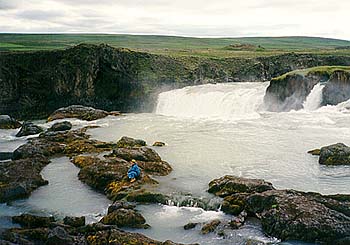
Islanders, they are self-absorbed. In the 13th century, they produced a vast body of literature, unlike anything in Europe, that was a meticulous description of themselves. These are the sagas: the tales, not of heroes or gods, but of ordinary people: the actual settlers who had come to the uninhabited land two hundred years before. There are hundreds of sagas, all interlocking: the same stories are told from different points of view; a person mentioned in passing in one becomes the protagonist of another. It is an enormous "human comedy" of love, greed, rage, lust, marriages and property settlements, travels, revenge, funerals and festivals, meetings, abductions, prophetic dreams and strange coincidences, fish and sheep. Nearly everyone in Iceland is descended from these people, and they know the stories, and the stories of what happened in the generations since.
One travels through Iceland with The Visitor's Key, an extraordinary guidebook that follows every road in the country step by step, as though one were walking with the Keeper of Memories. Iceland has few notable buildings, museums or monuments. What it has are hills and rivers and rocks, and each has a story the book recalls. Here was a stone bridge which collapsed behind an escaping convicted murderer, proving his innocence. Here lived a boy whose magical powers were such, he could wither grass. Here a man died of exposure in a snowstorm, not knowing he was a few yards from his house. It is said that two chests of silver are hidden somewhere on this hill. In this hot spring, a famous outlaw boiled his meat. A man was buried here because the horses carrying his body refused to take another step. Here a man who stole more sheep than he needed was slain by a 12-year-old boy. This farm refused shelter to a travelling pregnant woman, and was buried in a landslide that night. Some people have seen a man walking by this cliff with his head under his arm. Here was the home of a clergyman, who was honored abroad for his development of medicinal cod liver oil, and was also known for having kidnapped his bride. Here lived a popular postman in the 18th century.
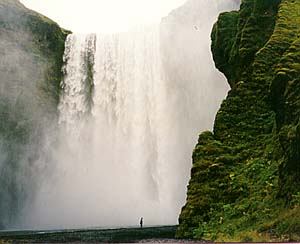
What other modern society so fully inhabits the landscape it lives in? Where else does the middle class still remember?
Sir Richard Burton, after the tropics and the deserts, was appalled by it. William Morris learned the language and translated some sagas, but preferred his reading to his two visits. Jules Verne never came, but placed the entrance to the center of the earth at the Snaefellsjökull volcano. Trollope came, late in life, and wrote a jolly account of huge meals and pretty women, but was shocked to find no bank. Here the young Auden, just before the war in Spain, wrote his strangest book.
They bake bread by putting it in the ground; they prefer their shark meat rotten. The use of pesticides is unknown among them. Nearly all the women have their first child before marriage. They allow no dogs in the capital. Their eyes are the exact pale blue shade of an iceberg. They believe in Hidden People. Their horses grow long coats in the winter, and sleep lying down. I have never seen so many kinds of moss.
2. Indriði Indriðason
In 1903, Einar G. Hjörleifsson, a journalist and newspaper editor in the small northern town of Akureyri, Iceland's second largest city, read a review in a foreign magazine of F.W.H. Myers' scholarly exposition of spiritualism, Human Personality and Its Survival of Bodily Death, and asked the county supervisor to try to obtain a copy for the local library. Before the book arrived many months later, Hjörleifsson had already written articles in its defense, and had attempted a few seances that produced no results. The following year, he moved to the capital, Reykjavík, and changed his name to Einar Kvaran -- a pseudonym that prefigures B. Traven and Arthur Cravan -- under which he would later become a nationally famous writer of, unexpectedly, realist novels.
The sittings continued with some like-minded enthusiasts. At one, the group became excited when a young woman wrote automatically about the death of a relative on a sheep farm in "West Iceland," the colony in Manitoba where a fourth of the population had emigrated. Weeks later, the news arrived that the relative was alive and well.
Disappointed, the group was at the point of disbanding when a printer's apprentice, Indriði Indriðason, twenty-two, raised without schooling on a distant croft, accidentally happened to attend a meeting. He had barely sat down when the table around which they had gathered began to shake violently. Indriði, in terror, ran out of the room. He was taken to Kravan's house, where a table trembled, moved across the floor, and flipped over.
Kvaran encouraged the reluctant Indriði, and the printer's apprentice first fell into a trance shortly before Easter, 1905, and began writing automatically. He saw shadowy beings and swore at them; he saw himself as two identical people, linked by a cord. He became afflicted with headaches, insomnia, and depression, and resolved to go to "West Iceland." Just before leaving, he fell ill: in his delirium, he saw a man with a grey beard operating on him. The man dictated a letter to Indriði which was given to Kvaran. If a group were to be formed, and certain instructions followed -- these are not now known -- greater things would be seen.
Kvaran founded the Experimental Society in the fall of 1905 and gathered prominent citizens: theologians, writers, a future Prime Minister, a Supreme Court judge, a member of Parliament. At the first meeting, the table suddenly lifted and banged into the chins of the assembled. Three men tried to push it down and could not. Indriði was not touching it. At the next session, a "control" appeared, who spoke through Indriði in his trance state, and instructed the group to meet every night.
Knocks were heard at the third meeting, on the walls and on the ceiling. At the next, clicks were heard in the air, like fingers snapping, moving around the room, though Indriði was motionless. Still later, lights flashed in the dark room, some white, some red, of different sizes and shapes; fifty-eight in all were counted. There was no equipment available in Iceland at the time that could produce such flashes. One night, Indriði described a major fire in Copenhagen. When the Danish papers arrived a month later, the information was proved correct.
In November, Indriði began to levitate. In the darkness of the meetings, it was difficult to see, but the sitters heard him bumping against the ceiling, crashing to the floor, smashing furniture as he came down. Once, a match was lit, and Indriði was seen, horizontal, with his head on a table and nothing else to support him.
On December 6, a man appeared standing in the light, with his back turned to the group. Indriði was in the corner, screaming. Strong gusts of wind blew through the room, disheveling hair and flipping the pages of books. Two weeks later, in the longest night of the sunless winter, Indriði, in his trance, suddenly shouted: "What are you going to do with those knives? No, no, no!" His left arm vanished. Seven sitters examined him, lit matches, and then lamps, but his arm could not be found. A half-hour later, it reappeared.
After a few consecutive evenings where the disappearance of his arm was repeated, Indriði became ill, and the meetings were suspended. They resumed in the darkness of the winter of 1906-07, when the seance room would become filled with a blinding white light. In the light a human would appear, dressed in a long white robe, speaking Danish with a heavy Copenhagen accent, and calling himself Mr. Jensen. He would appear repeatedly, for a few seconds at a time, in different parts of the room, sometimes standing behind Indriði's chair. At one meeting, forty witnesses saw him, including the Bishop of Iceland, the Magistrate of Reykjavík, and the British Consul. The Bishop insisted that further meetings be held at his own house, where, unexpectedly, the appearances of Mr. Jensen became more frequent and the light more intense.
In September 1907, Indriði went to visit a clergyman in the Westman Islands, where people lived on smoked fish and smoked puffin. There, he met an unpleasant apparition named Jón, described as a man in his shirt-sleeves, and troubles began.
On December 7, Indriði and his roommate, a theology student named Þórður, were sleeping in their house when a plate was thrown on the floor and Indriði's bed moved from the wall. The next night, Kvaran stayed with them; the doors were locked and a lamp was kept burning. Shoes began to be tossed around the room; then the head and foot of the bed alternately lifted and crashed down. A boot smashed the lamp and Indriði screamed that he was being dragged. He was pulled head-first out of the room, while the two men tugged at his ankles. They finally managed to get him back on the bed, where Indriði's legs were lifted up and the men could not force them down.
On the 10th, a man named Brynjólfur stayed with Indriði and Þórður. Candlesticks fell on the floor, and a hairbrush flew across the air. Indriði cried out that Jón was there. Brynjólfur lay down on top of Indriði on his bed, and the table next to them floated up and landed on them. After a period of quiet, Brynjólfur went back to bed. Indriði screamed that Jón was back. Water from a water-basin was thrown in Brynjólfur's face and a chamber pot sailed across the room. Brynjólfur again lay down on top of Indriði, and the bed moved from the wall. He was holding Indriði down as best he could, while a table rose and was banging him on the head. The men decided to leave the house, and began to get dressed. Indriði stood up and was thrown back on the bed. A bowl flew through the air, changed direction and splintered against a wall. Indriði screamed again, and Brynjólfur and Þórður saw him suspended horizontally. Both men tried to push him down, and they too were lifted into the air, as chairs, cushions, water-basins and water bottles were flung and smashed against the walls.
*
In a country with six months of near-total darkness: where the language recognized twenty-seven different kinds of ghosts: where everyone knew, from the sagas, the gossip of their ancestors of a thousand years before, and all who had come and gone since: where so much of the population was living and dying a world away to the west: on an island that was still a Danish colonial outpost, that until recently had not a single road across its eerie treeless landscape: where electricity was new to the city: where most of the population lived in remote settlements and spent the winters telling stories to each other, packed into tiny rooms in peat-covered cottages heated by the warmth of the animals and their own bodies: Indriði became a celebrity, the most famous Icelander of his time.
The Experimental Society built a special house where he could live and work, with a seance room that could hold a hundred people, a large crowd in the minuscule city. The popularity of the seances, ridiculed in the local press, attracted the attention of Iceland's most honored scientist, Guðmundur Hannesson, founder of the Icelandic Scientific Society, twice President of the University of Iceland, Reykjavík City Council member, and leading light in both the Icelandic and Danish Associations of Physicians. Guðmundur decided to expose Indriði by subjecting the gatherings to scientific methods of verification.
The hall was sealed, and a man directed to hold Indriði's hands throughout the session. A megaphone on an iron stand rose from a table and a voice spoke through it into Guðmundur's ear. A heavy music box flew through the air playing a melody. A table turned upside-down and a bench was dragged; loose objects careened. There were knocks and voices.
Guðmundur next inspected the ceiling and floor for hidden compartments. He constructed a net, stretched tight and nailed to the room on all sides, to serve as a barrier between Indriði and the audience. All possible apertures and crevices were checked and sealed, and movable objects placed out of Indriði's reach. Guðmundur reported: "It was the same as at the previous seance: everything went mad and tumbled about. It was even noisier than it was on the previous occasion."
For the third meeting, the examination of the room was even more thorough, and Indriði was undressed and searched. Only two people besides Guðmundur, Indriði and his "watchman" were allowed to attend. Guðmundur wrote: "This is no joke. It is a life-and-death struggle for sound reason and one's own conviction against the most execrable form of idiocy and superstition." At the seance objects flew. The chair was pulled out from under Indriði and smashed. Guðmundur, standing away from the others, was struck hard in the back, as though by a closed fist. Indriði was pulled feet first toward the ceiling as the "watchman" tried to haul him down. Voices of different kinds and with different accents were heard cursing; the sitters' chairs were pulled from them. A lectern firmly nailed to the floor was torn loose, and Indriði and the "watchman" were dragged about. Broken glass and trash were thrown in Guðmundur's face from a direction where no one was present. Surveying the rubble of the room, Guðmundur concluded that "there is no possibility of explaining" what had happened.
Guðmundur attended twenty more seances, each time inventing stricter controls: The meetings were moved to other houses, the location announced only minutes before, with guards stationed outside. Indriði was undressed and put into a kind of straitjacket to keep him from moving. Phosphorescent tape was ordered from Europe and placed on Indriði and various objects to observe their movements. The phenomena were repeated: flying objects; levitation; winds blowing from nowhere; varied voices in Icelandic, French, Danish, and Swedish, some speaking simultaneously, often cursing; invisible punches; furniture being smashed, the megaphone and the music box swinging wildly over the heads of the audience. A woman's voice, musically trained, was heard singing when no women were present. Once, the room filled with fog.
Guðmundur published his findings in scientific journals. He wrote: "It is my firm conviction that the phenomena are unquestionable realities."
In the summer of 1909 Indriði went to visit his parents with his recent fiancée. They both caught typhoid, and she died. Too weak to continue, he never held another seance. He married another woman, and they had a daughter who died in infancy. Indriði contracted tuberculosis and died in a sanitarium in 1912 at age 29.
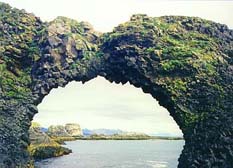
3. An Archaeology of Dreams [The North, c. 1000]
Þorbjörg of Indriðastaðir dreamed that eighty wolves passed by with flames coming from their mouths, and among them was a white bear.
Glaumvör dreamed that a bloody sword was sticking out from her husband's tunic, and that a river ran through the house, sweeping away all their things.
Hersteinn Blund-Ketillson dreamed he saw his father on fire.
Ásmundar Kappabani dreamed that a group of women stood over him, holding weapons, and said: "You are expected to be a leader, yet you fear eleven men."
King Gormr dreamed that three black oxen came out of the sea, ate the grass down to the roots, and went back to the sea. Then he heard a great crash.
Báðr dreamed that a giant tree grew from his father's hearth, covered with blossoms, and that one of the branches was solid gold.
Gísli dreamed he went to a house, filled with friends and relatives, and they sat by seven fires, some flaming brightly and some nearly burnt out. He dreamed that a woman came to him on a grey horse and invited him to her house; they rode together, and went inside, and there were soft cushions on the seats. Then he dreamed that another woman came, and washed his head in blood.
Blindr dreamed he saw King Haddingr's falcon with all its feathers plucked out.
Guðrún dreamed she was wearing an ugly hat; she wanted to take it off, but people told her not to, so she pulled it off her head and threw it in a brook. She dreamed she was standing by a lake, wearing a silver ring on her arm which slipped off into the water. She dreamed she was wearing a gold ring on her arm which slipped off, hit a rock, broke into pieces, and the pieces began to bleed. She dreamed she was wearing a gold helmet, set with precious stones, and that it was so heavy she could not walk.
Kostbera dreamed that the sheets of her husband's bed were on fire.
Þorkell Eyjólfsson dreamed his beard was so large it covered the land.
Þorgils Örrasbeinsstjúper dreamed he looked at his knee, and five leeks were growing out of it.
Þorgils Böðvarsson dreamed that a tall woman came to his door, wearing a child's cloak, and she was very sad.
Hálfdan dreamed he had hair more beautiful than anyone, that it grew in all colors and all lengths: some fell down to his knees, some to his hips, some to his shoulders, and some were merely tufts.
Ragnhildr dreamed she took a thorn out of her smock and it grew from her hand into a great tree that was red at the bottom, green in the middle, and snow-white at the top.
Þórsteinn Surtr dreamed he was awake but everyone else was asleep; then he dreamed he fell asleep and everyone else woke up.
Þórsteinn Uxafótr dreamed that a burial mound opened and a man dressed in red came out. He greeted him pleasantly and invited him into his house. They descended into the mound, which was well furnished. On his right he saw eleven men, sitting on a bench, dressed in red. On his left he saw twelve men, sitting on a bench, dressed in blue.
King Sverrir dreamed that a man came to his bed and told him to follow. They walked out of town and into the countryside, where they came to a fire on which a man was being roasted. The guide told him to sit and eat, and gave him a roasted human leg. He ate reluctantly, but with each bite he enjoyed it more, and couldn't stop eating.
Jón, bishop of Hólar, dreamed that he was praying before a large crucifix, that Jesus bent down and whispered something in his ear, but he did not understand the words.
Þuríðr Þorkelsdóttir dreamed that her dead husband appeared and told her not to think ill of her son-in-law.
Flosi dreamed that he and his friends were in Lómagnúpr, looking at the mountain. Then the peak opened, and a man came out, wearing a goatskin jacket and carrying an iron staff. He called each of the men by his name. Flosi asked him what the news was, and the man told him there wasn't any.
Án the Black dreamed that a repulsive woman appeared by his bed, cut out his entrails, and stuffed his body with brushwood. Then he dreamed that she took out the brushwood and put his entrails back.
Þórhaddr Hafljótsson dreamed his tongue was so long it wound around his neck.
Sturla Sigvatsson told his friend that he had dreamed that he had a sausage in his hand, that he had straightened it out, broken it in half with his hands, and given half to this same friend. Moreover, he knew that the dream was occurring now, in the same moment of time in which he was telling the dream to his friend, holding a sausage in his hand.
King Atli dreamed that the reeds he wanted to grow were torn up by the roots, reddened in blood, brought to his table, and given him to eat. He dreamed he ate the hearts of hawks, with honey.
A man from Skagafjörðr dreamed he came into a great house where two women were rocking. They were covered with blood, and blood rained on the windows.
Þorleifr Þorgilsson dreamed his sister gave him a piece of cheese, and that all the crust was cut off it.
|
|

 Ísland
Ísland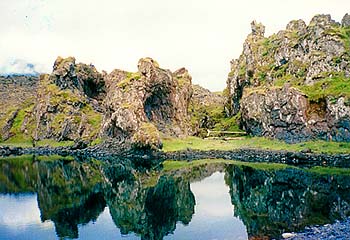
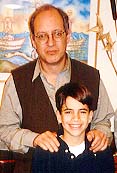 Writer Eliot Weinberger and photographer Stefan Weinberger, New York, 1998. Photo copyright © John Tranter 1998.
Writer Eliot Weinberger and photographer Stefan Weinberger, New York, 1998. Photo copyright © John Tranter 1998.